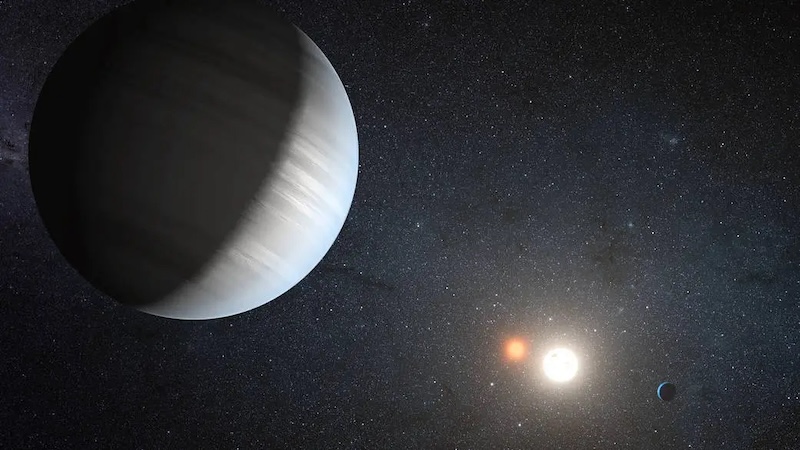In the Star Wars franchise, Luke Skywalker hails from a fictional planet called Tatooine, a world with two suns. But, in the real universe, can exoplanets in multi-star systems have enough stability to be habitable? This question has been a subject of much recent research. And now researchers at Yale University in New Haven, Connecticut, say yes. On February 22, 2024, they said in a new paper that the universe leans toward orderly alignment in contrast to chaotic misalignment. By that logic, multi-star systems can contain temperate and potentially habitable worlds.
The researchers published their peer-reviewed findings in The Astronomical Journal on February 22, 2024.
EarthSky lunar calendars are back in stock! And we’re guaranteed to sell out, so get one while you can. Your support means the world to us and allows us to keep going. Purchase here.
Tatooine exoplanets in binary star systems
Tatooine was a fictional representation of a planet with two stars. Those are called binary star systems, and they’re quite common in the real universe.
For this study, the researchers, led by Malena Rice at Yale University, focused on 40 binary star systems. In these systems, planets orbit around one of the stars, and in turn, the second star orbits that star and its entire planetary system. The stars are gravitationally bound together, hence binaries. All the binary star systems they studied have at least one planet. Rice and her colleagues found there is a surprising amount of alignment within these systems. Rice explained:
We show, for the first time, that there is an unexpected pile-up of systems where everything is aligned. The planets orbit precisely in the same direction that the first star rotates, and the second star orbits that system on the same plane as the planets.
The researchers used various sources to create 3D geometries of planets in binary star systems. These included the Gaia DR3 catalog of high-precision stellar astrometry, the NASA Exoplanet Archive’s Planetary Systems Composite Parameters table (PSCompPars) and the TEPCat catalog of exoplanet spin-orbit angle measurements.
Perfect alignment
The research team found alignment to be common in the binary star systems. And nine of those systems had “perfect alignment.” As the paper explained:
We identify a population of nine exoplanet host systems that each exhibit evidence of joint spin–orbit and orbit–orbit alignment. The joint alignment of seven of these systems was demonstrated for the first time: six binary star systems (CoRoT-2, DS Tuc, HAT-P-1, HAT-P-22, HD 189733 and TrES-4) were found to exhibit evidence of full system alignment and one triple-star system (V1298 Tau) exhibits evidence of full alignment between the host star’s transiting exoplanet companion and one of the two companion stars.
Our results highlight an observed regime within which moderately wide-separation stellar companions push their neighbors’ protoplanetary disks, and therefore the planetary systems that emerge from those disks, toward an aligned state, approaching a more general three-body equilibrium (Hut 1981) and enhancing order in exoplanet systems. Further observations of similar, well-constrained systems offer the potential to provide precise dynamical limits on protoplanetary disk properties, offering a new lens through which disk properties – including masses, viscosities and lifetimes – may be constrained.

Good news for potentially habitable worlds
The results are also encouraging for the possibility of life existing on planets in these kinds of aligned systems. The environment would be more stable for these Tatooine exoplanets than in non-aligned systems, as Rice said:
It could be an indication that planetary systems like to push toward an orderly configuration. This is also good news for life forming in those systems. Stellar companions that are aligned differently can wreak havoc on planetary systems, toppling them over or flash heating planets over time.
Habitable planets would still be unlike Earth in some ways, though. During some seasons, because there are two stars, half of a planet would be in sunlight from one star, while the second star would light up the other side. You might think that sunlight from two stars would make the planet too hot, but it wouldn’t. That’s because one of the stars is much farther away than the other star. Therefore, its sunlight and heat would be weaker.
During oOther seasons, both stars would light up the same side of the planet. And because of the distance differences, one of the stars would look much larger and brighter than the other one.
While Tatooine was a fictional world, there are many planets out there that do indeed have two – and sometimes more – suns. We don’t know if any of the real Tatooine exoplanets are inhabited yet, but the more we learn, the more likely it seems.
Bottom line: Researchers at Yale University said habitable planets in binary star systems – so-called Tatooine exoplanets – may be more common than previously thought.
Source: The Orbital Geometries and Stellar Obliquities of Exoplanet-hosting Multistar Systems
Via Yale University
Read more: 3D map of a million binary stars
Read more: Can binary-star planets support life?